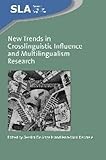New Trends in Crosslinguistic Influence and Multilingualism Research / ed. by Gessica De Angelis, Jean-Marc Dewaele.
Material type: TextSeries: Second Language AcquisitionPublisher: Bristol ; Blue Ridge Summit : Multilingual Matters, [2011]Copyright date: ©2011Description: 1 online resource (128 p.)Content type:
TextSeries: Second Language AcquisitionPublisher: Bristol ; Blue Ridge Summit : Multilingual Matters, [2011]Copyright date: ©2011Description: 1 online resource (128 p.)Content type: - 9781847694423
- 9781847694430
- 404.2
- online - DeGruyter
| Item type | Current library | Call number | URL | Status | Notes | Barcode | |
|---|---|---|---|---|---|---|---|
 eBook
eBook
|
Biblioteca "Angelicum" Pont. Univ. S.Tommaso d'Aquino Nuvola online | online - DeGruyter (Browse shelf(Opens below)) | Online access | Not for loan (Accesso limitato) | Accesso per gli utenti autorizzati / Access for authorized users | (dgr)9781847694430 |
Frontmatter -- Contents -- Introduction -- Chapter 1: Awareness and Affordances: Multilinguals versus Bilinguals and their Perceptions of Cognates -- Chapter 2: Perceived Redundancy or Crosslinguistic Influence? What L3 Learners’ Material Can Tell us About the Causes of Errors -- Chapter 3: Crosslinguistic Interaction and Metalinguistic Awareness in Third Language Acquisition -- Chapter 4: Transfer from L3 German to L2 English in the Domain of Tense/Aspect -- Chapter 5: Perception of Preposition Errors in Semantically Correct versus Erroneous Contexts by Multilingual Advanced English as a Foreign Language Learners: Measuring Metalinguistic Awareness -- Chapter 6: ‘Luisa and Pedrito’s Dog will the Breakfast Eat’: Interlanguage Transfer and the Role of the Second Language Factor -- Chapter 7: Crosslinguistic Influence in Multilingual Language Acquisition: Phonology in Third or Additional Language Acquisition
restricted access online access with authorization star
http://purl.org/coar/access_right/c_16ec
This book presents the latest developments in crosslinguistic influence (CLI) and multilingualism research. The contributors, both veteran researchers and relative newcomers to the field, situate their research in current debates in terms of theory and data analysis and they present it in an accessible way. The chapters investigate how and when native and non-native language knowledge is used in language production. They focus on lexis, syntax, tense-aspect, phonology of multilingual production and link it to a range of concepts such as redundancy, affordances, metalinguistic awareness and L2 status. The empirical data have been collected from participants with a wide combination of languages: besides English, German, French and Spanish, there is Finnish, Swedish, Polish, Chinese and Catalan.
Mode of access: Internet via World Wide Web.
In English.
Description based on online resource; title from PDF title page (publisher's Web site, viewed 01. Dez 2022)


